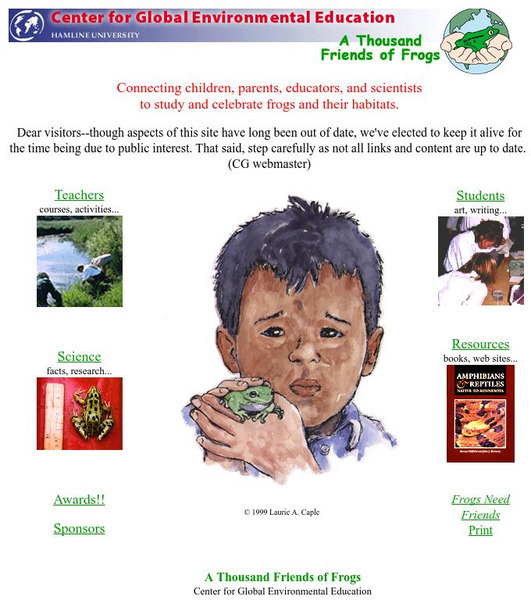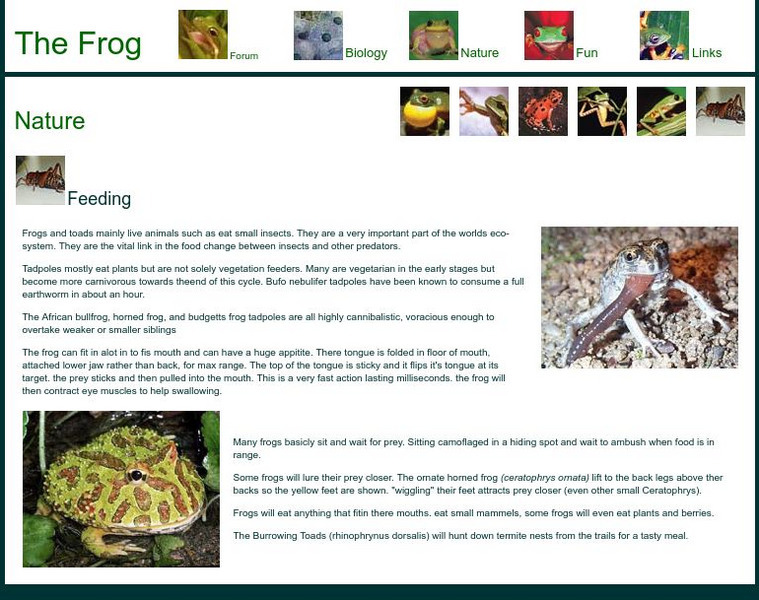PBS
Pbs Teachers:costa Rica: Why So Many Frogs?
Explore the different stages in the growth of a frog, explain why organisms produce large numbers of young and determine the survival rate of a population of tadpoles under controlled conditions.
Alabama Learning Exchange
Alex: Leap Into the Life Cycle of a Frog
During this lesson plan students explore the life cycle of a frog. They will raise frogs in the classroom from tadpoles and document and describe each stage of the life cycle.
Other
All About Frogs: Life Cycle of a Frog
Understand the reproduction and life cycle of a frog from mating through spawn, eggs, tadpoles, and growing legs to the final frog. Nice details.
Natural History Museum
Natural History Museum: Reptiles, Amphibians and Fishes
This online exhibit from the Natural History Museum branches out in many fields to cover the broad topics of reptiles, amphibians and fishes. Thirteen subtopics are provided including several videos and informative articles.
Other
Center for Global Environmental Education: A Thousand Friends of Frogs
An in-depth site about the world of frogs. The site includes teacher, student, science, and research sections. There are plenty of facts and activities.
Other
The frog.org: Feeding
TheFrog.org provides information about the lives of frogs. This particular page discusses the diet of a typical frog.
Ducksters
Ducksters: Amphibians for Kids: Frogs, Salamanders, and Toads
What is an amphibian? Kids learn about these cold blooded animals including salamanders, frogs, and toads. Lifecycle such as tadpole and metamorphosis.
Math Science Nucleus
Math/science Nucleus: Frog Poem Animation
This animation outlines the life of a frog in a storybook format through a poem. The poem covers the stages in the life of a frog.
ClassFlow
Class Flow: Frogs
[Free Registration/Login Required] This flipchart is a brief introduction to frogs, their habitats, life cycle, and some fun facts!
Environmental Education for Kids
Eek!: Amphibians
Amphibians are cold-blooded, smooth-skinned vertebrates. Most live some of their life in water and some on land. The most common amphibian critter is a frog but there are many others. Read about Wisconsin's many amphibians here.
Curated OER
Pocket Frog
Find out what you don't know about frogs, frogs vs. toads, frog size, sight, environment, legs, mouth, food, color, defense, tadpoles, and more.
Other
Springboard Magazine: The Circle of Life
A brief explanation of life cycle is provided along with pictoral respresentations of three different examples of life cycles (apple tree, butterfly and frog). The term metamorphosis is introduced and the resouce has an interactive...
Curated OER
[Frog Spawn]
Understand the reproduction and life cycle of a frog from mating through spawn, eggs, tadpoles, and growing legs to the final frog. Nice details.
Ducksters
Ducksters: American Bullfrog
Kids learn about the American Bullfrog, large amphibians and frogs that can jump high.
Curated OER
[Toads Mating]
Understand the reproduction and life cycle of a frog from mating through spawn, eggs, tadpoles, and growing legs to the final frog. Nice details.
Curated OER
[Toad Spawn]
Understand the reproduction and life cycle of a frog from mating through spawn, eggs, tadpoles, and growing legs to the final frog. Nice details.
Curated OER
[Froglet]
Understand the reproduction and life cycle of a frog from mating through spawn, eggs, tadpoles, and growing legs to the final frog. Nice details.










